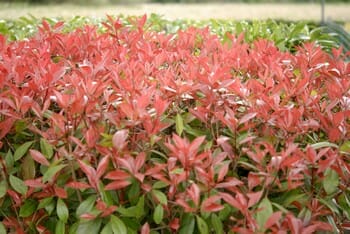
The Photinia is a medium sized evergreen shrub. Planted within a free hedge, it will enliven the garden in spring, not by its rather discreet flowers, but by its young foliage with a bright red hue. A brilliant shrub, so much so that we only see it and the association of neighboring species with white flowers in the hedge, will put it a little more in value.
The Photinia supports any type of soil, but it shows a preference for slightly acid soils, rich in organic matter.
Rather sensitive to drought, it appreciates regular watering in the middle of summer and even, on hot evenings, a shower of its foliage. Conversely, it hates heavy, compact and humid soils. In clay soil, consider bringing a little river sand when planting to lighten and drain the substrate.
Decorative foliage

The Photinia ignites from the beginning of spring, sometimes giving a little air of autumn in April. The large leaves, shiny and glazed, then gradually turn green, so that in the height of summer, it blends into the rest of the hedge and even gives center stage to neighboring species. The inconspicuous, dew-white flowers bloom in panicles in May-June, but don’t really have the same appeal as the foliage.
Easy to trim
In the first years following its establishment, pruning is even essential, to avoid growth in height, which would inevitably be accompanied by a thinning of the base. So remember to prune it severely at the beginning, evenly, to force it to branch out, giving it a rounded habit. After three to four years, a simple maintenance pruning, limited to the removal of faded flowers, will suffice at the same time as it will stimulate the production of new red shoots.
Combine photinia with Portugal laurel as a hedge . The complementarity of their colors (young red shoots for the first and chartreuse green for the second) works wonders!
Which Photinias to plant?
The star of the family is the Photinia fraseri ‘Red Robin’ variety , highly valued for its brilliant red shoots. Fast growing, care should be taken with pruning. Its only fault, but not the least, a sensitivity perhaps stronger than the others to diseases, in particular to fire blight which causes great devastation quickly. If you intend to create a container hedge , to delimit a terrace for example, choose the dwarf cultivar Little Red Robin .
Photinia fraseri ” Robusta compact” is, as its name suggests, more dense, bushy and branched than the previous one. Its foliage is less bright than ” Red Robin ” (rather orange than red) but its resistance to cold is better.
Other, less famous and more eccentric cultivars exist. The Photinia fraseri pink marble is a good example. It produces purple shoots, mottled with pink, which turn green rimmed with cream in summer.
So there are Photinias for all tastes and all types of hedges! We won’t complain.
